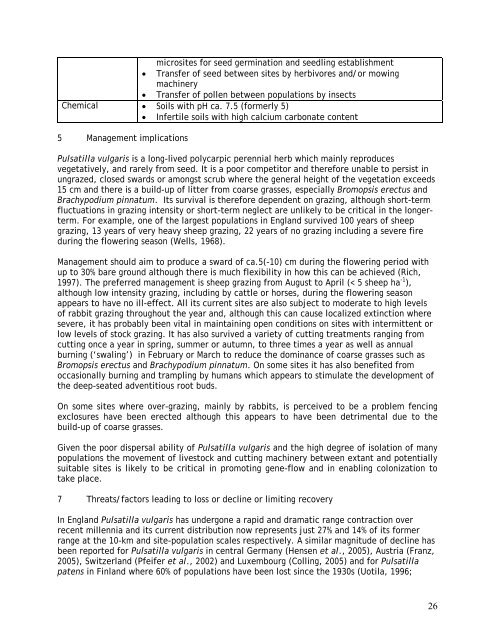Pulsatilla vulgaris (L.) Mill. - Plantlife
Pulsatilla vulgaris (L.) Mill. - Plantlife
Pulsatilla vulgaris (L.) Mill. - Plantlife
Create successful ePaper yourself
Turn your PDF publications into a flip-book with our unique Google optimized e-Paper software.
microsites for seed germination and seedling establishment<br />
• Transfer of seed between sites by herbivores and/or mowing<br />
machinery<br />
• Transfer of pollen between populations by insects<br />
Chemical • Soils with pH ca. 7.5 (formerly 5)<br />
• Infertile soils with high calcium carbonate content<br />
5 Management implications<br />
<strong>Pulsatilla</strong> <strong>vulgaris</strong> is a long-lived polycarpic perennial herb which mainly reproduces<br />
vegetatively, and rarely from seed. It is a poor competitor and therefore unable to persist in<br />
ungrazed, closed swards or amongst scrub where the general height of the vegetation exceeds<br />
15 cm and there is a build-up of litter from coarse grasses, especially Bromopsis erectus and<br />
Brachypodium pinnatum. Its survival is therefore dependent on grazing, although short-term<br />
fluctuations in grazing intensity or short-term neglect are unlikely to be critical in the longerterm.<br />
For example, one of the largest populations in England survived 100 years of sheep<br />
grazing, 13 years of very heavy sheep grazing, 22 years of no grazing including a severe fire<br />
during the flowering season (Wells, 1968).<br />
Management should aim to produce a sward of ca.5(-10) cm during the flowering period with<br />
up to 30% bare ground although there is much flexibility in how this can be achieved (Rich,<br />
1997). The preferred management is sheep grazing from August to April (< 5 sheep ha -1 ),<br />
although low intensity grazing, including by cattle or horses, during the flowering season<br />
appears to have no ill-effect. All its current sites are also subject to moderate to high levels<br />
of rabbit grazing throughout the year and, although this can cause localized extinction where<br />
severe, it has probably been vital in maintaining open conditions on sites with intermittent or<br />
low levels of stock grazing. It has also survived a variety of cutting treatments ranging from<br />
cutting once a year in spring, summer or autumn, to three times a year as well as annual<br />
burning (‘swaling’) in February or March to reduce the dominance of coarse grasses such as<br />
Bromopsis erectus and Brachypodium pinnatum. On some sites it has also benefited from<br />
occasionally burning and trampling by humans which appears to stimulate the development of<br />
the deep-seated adventitious root buds.<br />
On some sites where over-grazing, mainly by rabbits, is perceived to be a problem fencing<br />
exclosures have been erected although this appears to have been detrimental due to the<br />
build-up of coarse grasses.<br />
Given the poor dispersal ability of <strong>Pulsatilla</strong> <strong>vulgaris</strong> and the high degree of isolation of many<br />
populations the movement of livestock and cutting machinery between extant and potentially<br />
suitable sites is likely to be critical in promoting gene-flow and in enabling colonization to<br />
take place.<br />
7 Threats/factors leading to loss or decline or limiting recovery<br />
In England <strong>Pulsatilla</strong> <strong>vulgaris</strong> has undergone a rapid and dramatic range contraction over<br />
recent millennia and its current distribution now represents just 27% and 14% of its former<br />
range at the 10-km and site-population scales respectively. A similar magnitude of decline has<br />
been reported for <strong>Pulsatilla</strong> <strong>vulgaris</strong> in central Germany (Hensen et al., 2005), Austria (Franz,<br />
2005), Switzerland (Pfeifer et al., 2002) and Luxembourg (Colling, 2005) and for <strong>Pulsatilla</strong><br />
patens in Finland where 60% of populations have been lost since the 1930s (Uotila, 1996;<br />
26

















